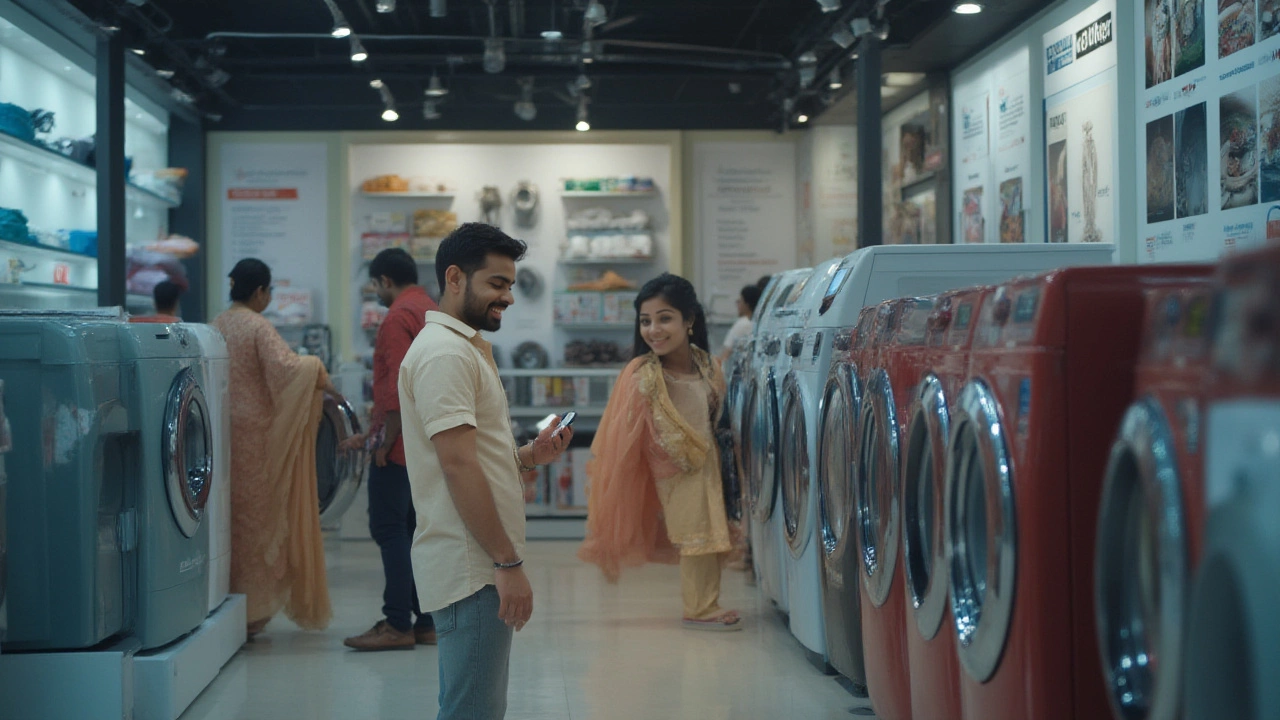
You walk into any appliance store and spot the Maytag badge right away. It's got that reputation: sturdy, no-nonsense, built to last. But let’s get honest for a minute—Maytag is not the only heavyweight around, and sometimes the price or just the design has you looking twice. Maybe your family’s like mine—kids always testing the limits of the washing cycle, the dryer drum somehow ending up with marbles inside. So you want something that can handle the chaos. Not everyone knows there’s a whole pack of brands in Maytag’s weight class, trading punches on reliability, price, tech, and after-sales service. Curious who these contenders are? Let’s get stuck in.
Why Maytag Sets the Bar for Home Appliances
Maytag isn’t just a name your gran throws around. For over 100 years, these folks have churned out robust washers, dryers, dishwashers, and fridges that can take a beating. The brand’s “Dependability People” ads from the 1980s weren’t just marketing spin—they leaned heavy on their reputation for machines that didn’t quit. In 2006, Whirlpool actually bought Maytag, but the original DNA—big, industrial-strength parts and a tendency to focus on easy repairs—still runs deep. That’s why I’m not shocked when you see a 15-year-old Maytag still banging away in someone’s basement.
This reliability is reflected in user reports and major review sites. Consumer Reports, for example, regularly puts Maytag at the top or just behind their absolute leader for washer and dryer satisfaction. One fun stat: the average life expectancy of a Maytag washer is about 10-13 years, while some users claim their machines last 20 years or more. The company’s warranties—especially with those Powerwash and Commercial Technology lines—also show they aren’t shy about backing up their claims.
But ‘dependable’ doesn’t always mean ‘right for everyone.’ Maytag tends to stick with traditional controls longer, sometimes losing out to flashier touchscreen features or smartphone compatibility. Their price points, particularly outside of sales, hover around the middle or high end.
So who else soaks up the knocks and keeps spinning? Let’s compare.
The Closest Rivals: Brands That Stack Up Against Maytag
Go down the aisle and you’ll notice five names always getting compared to Maytag: Whirlpool, LG, Samsung, GE Appliances, and Electrolux. Each one carries its own perks, strengths, and let’s be honest, sometimes annoying little quirks. But here’s why they’re neck-and-neck with Maytag.
Whirlpool: If someone swapped out the badge on a Maytag washer and stuck a Whirlpool one on, most people couldn’t tell the difference. No joke—Whirlpool literally owns Maytag and builds many models with the same guts. Repairs, spare parts, and reliability ratings are similar. Whirlpool tends to play it safe on features, but gets high marks for value, making it a go-to for families who want something basic but tough.
LG: LG shakes up the scene with style and innovation. Front-loaders with fancy steam cycles, WiFi for remote starts, clever drum designs for gentler cleaning—it’s all there. LG keeps sweeping up awards for customer satisfaction. JD Power crowned their washers ‘Highest in Customer Satisfaction’ several times in the last decade. They’re great if you want smart features and efficient running costs, though service in smaller towns can still be a pain.
Samsung: Samsung pushes smart tech even further than LG, with machines that look like they belong in a spaceship. Their front-load washers are famous for Vibration Reduction Technology, big drums, and bubble cleaning (it actually works). They back their gear with warranties and price points that often undercut both Maytag and LG, but some reliability concerns from 5–8 years in still pop up in a few long-term reviews.
GE Appliances: American classic, revamped. GE is all about smart home integration and powerful washers built for big families. Good for people who want to set-and-forget their cycles via app, or care most about energy efficiency. Their ‘Ultrafresh Vent System’ helps cut down on the mildew funk that can haunt front-loaders—if you know, you know. Repairs and spare parts are easy to get, but expect to pay a touch more for new models with fancy features.
Electrolux: Built to last, especially in Europe, but their North American models are pretty solid too. Electrolux washers and dryers feel more premium, but they don’t always match Maytag’s rugged reliability (especially on some dryers). Where they shine is with gentle washing—amazing for those clothes you’d rather not turn into play costumes after a big cycle mishap.
Take a look at how these brands compare with a quick stats table:
| Brand | Known For | Avg. Washer Lifespan (Years) | Warranty (Washer) | Main Weakness |
|---|---|---|---|---|
| Maytag | Heavy-duty reliability | 11-15 | 10 year motor/drum | Fewer smart features |
| Whirlpool | Ease of repair & value | 10-14 | 10 year motor/drum | Plain designs |
| LG | Smart features & efficiency | 10-13 | 10 year motor | Service delays |
| Samsung | Innovation & price | 9-12 | 10 year motor | Mixed long-term reliability |
| GE Appliances | Smart & energy-efficient | 10-14 | 10 year motor/drum | Price on top models |
| Electrolux | Delicate cleaning | 10-12 | 10 year motor | Some dryers underwhelm |
The hottest tip? If *longevity* is your goal, hunt for models with simple dial controls, mechanical buttons, and a reputation for easy repairs. Fancy doesn’t always equal durable—think about toddlers mashing touchscreens or that one time your wet hand fried a control board.

Shopping for Sturdy Alternatives: Practical Tips and Tricks
Finding a brand rival to Maytag means paying attention to more than just a logo or a piece of chrome. Everyone wants a laundry machine or dishwasher that’s easy as Sunday morning, but buyers still get tripped up by confusing labels and marketing mumbo-jumbo. If you want a workhorse, walk past buzzwords like "SmartThinQ" or "DeepWaterWash" and check the real specs.
Build quality comes down to what’s inside. Stainless steel drums don’t just look fancy—they hold up better against coins, buckles, and the occasional mystery gunk from your youngest’s pockets. Belt drive systems hold up longer than direct drives, but they cost a smidge more to fix. If you lift the lid (with permission!) in a showroom and feel something solid, chances are it’ll last. Maytag and Whirlpool consistently use commercial-grade parts in many core models, while Electrolux and GE sometimes reserve their good stuff for higher-end lines.
Bounce the door, twist the knobs, and peek at the hinges. Feel for weight—heavier doors usually mean less plastic inside. Flip the unit around and see if the back is all metal or cheap plastic. Things like that tell you more than a glossy finish ever will.
Energy efficiency matters more if you’re in England, like me, where electricity is pricey and homes run smaller. Look at labels: A-rated (in Europe, that now means ‘A’ is actually top-tier, after a 2021 label shakeup), or ‘Energy Star’ in the US. LG and GE lead here, but most Maytag and Whirlpool kits aren’t far behind. High-spin speeds cut drying times—2,000 rpm beats out 1,200 every time, both on energy and convenience (unless you fancy laundry draped over the radiators, which my wife really doesn’t).
Noise is another dealbreaker. If your machine lives near bedrooms or your kitchen is part of one big open space (thanks, modern housing), you want quiet. LG and Samsung dominate on silence, but GE’s newer top-loaders are giving them a run for their money.
Here’s a checklist to help you spot a machine that can survive both teens and muddy football kits:
- Check the warranty: Ten years on the motor means a confident brand, not just a sales pitch.
- Ask how easy it is to get spare parts in your area. Local repair techs matter more than phone helplines.
- Test the controls. Mechanical dials last longer than touchscreen panels, which hate grubby fingers.
- Does the drum feel thick or tinny? Thicker means tougher.
- Look up user reviews from a few years back, not just on the day they bought it.
Weird tip: Go for models that have been around (with small tweaks) for a few years. If a manufacturer keeps tacking ‘Series 3’ or ‘Mark IV’ onto the name, they’re probably working out real-world bugs instead of rushing out a new design every Christmas.
Making the Choice: Key Differences and What Matters Most
Here’s what it comes down to: Maytag and Whirlpool lead for old-school durability and basic design. LG and Samsung are the kings of smart, sleeker living, while GE and Electrolux bring the fancy touches and energy savings. So, which way do you jump?
If you need to replace a 15-year-old Maytag, Whirlpool’s mainstream top-loaders or the latest Maytag models will fit your workflow and probably survive the next round of school uniforms, pets, and life’s messes. Want smart features? LG’s AI routines can sort laundry temperature based on load weight, send alerts to your phone, or even reorder detergent when you’re running low (handy, if you forget after three cups of coffee). Samsung lets you stack, flex, and customize almost everything, while keeping the prices competitive—and yes, some stores will haggle.
For busy homes, quick cycles and a big drum top the wishlist. LG and GE’s front-loaders fit giant duvets and crank through laundry superfast. But watch out for mold growth in rubber gaskets on any front-loader—use the self-clean cycle, and leave the door open every now and then. Electrolux is a dream for delicates, but the flipside is their dryers can be slower and a bit less tough on party clothes caked in mud.
One last thing nobody tells you: service networks. It’s no use having a clever machine if the nearest specialist lives three counties away. Maytag and Whirlpool wins this one hands-down in the UK and North America. LG’s coverage has improved but can still leave you stranded if you live outside a big city. Samsung and GE are improving, but a quick chat with your local repair guy (the one with oil stains and a mug of tea) pays off before you buy.
Here’s a quick ‘Who Should Buy What?’ cheat sheet:
- Stick with Maytag or Whirlpool if ruggedness and local repairs are all that matters.
- Pick LG if you want smart features mixed with solid running costs—and you live near a big town.
- Choose Samsung for style, price, and top-tier quiet (if you can accept minor hardware gripes).
- Go GE for seamless smart home links and tackling weird stains or big dog-towels.
- Electrolux is for those who care most about gentle washing—think vintage jumpers or wedding outfits.
Maytag’s earned its stripes with families who punish their appliances. But the brand’s rivals are plenty capable now—and in some cases, the better fit as homes and needs change. The secret is knowing which strengths match your family, your priorities, and, sure, your budget. I won’t pretend shopping for appliances is as fun as a weekend in Brighton’s arcades, but play it smart and you’ll be laughing when your washer is still ticking along long after the warranty’s a distant memory.